

There’s a better way to do business intelligence, and it starts with Sigma. See why teams of all sizes are leaving their legacy platforms behind.

You’ve already invested in a cloud data warehouse. Now, optimize it.
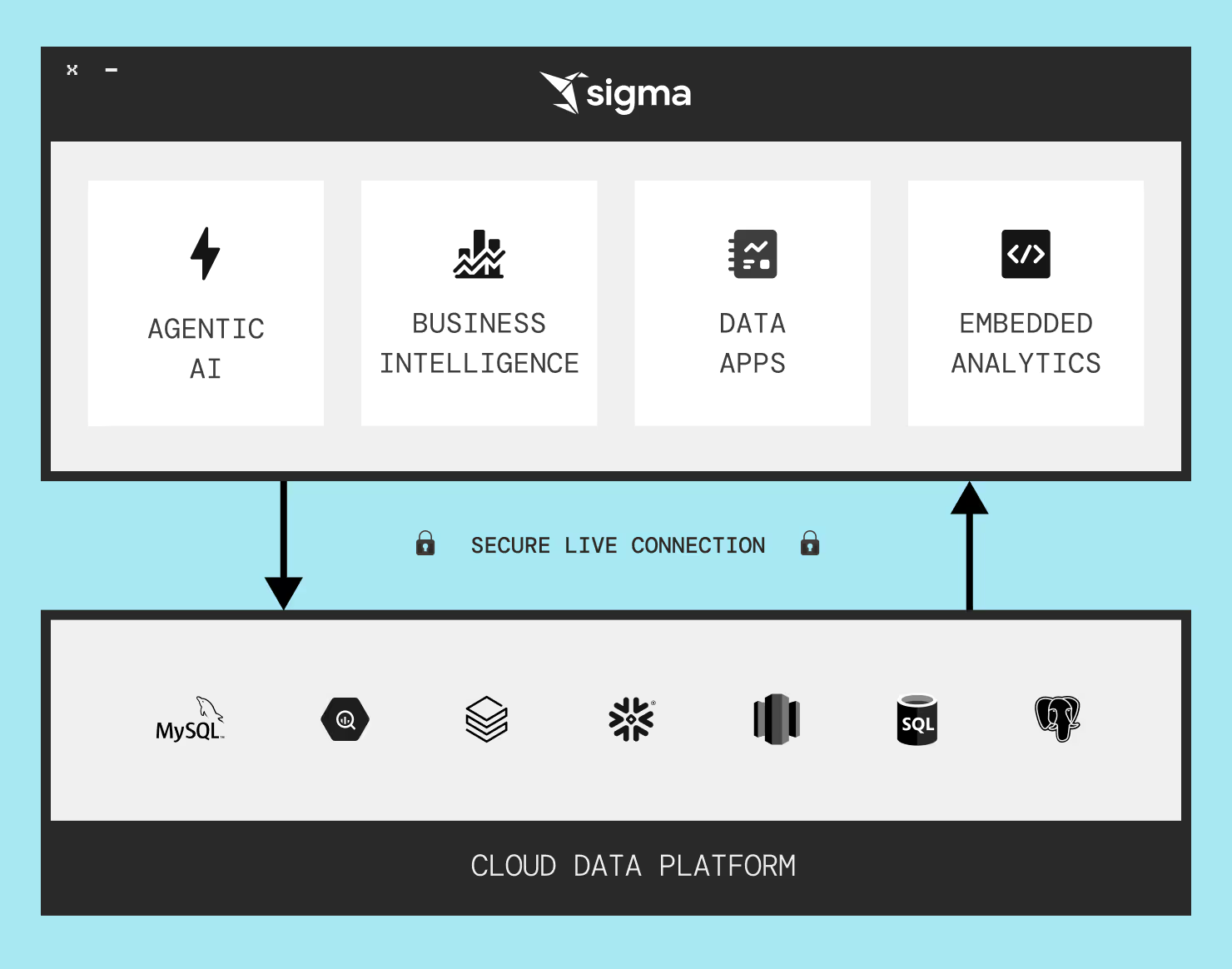
Sigma direct queries the warehouse and inherits permissions, so data stays consistent and secure.
Anything your warehouse can do, Sigma can leverage—including the latest and greatest AI models on the market.
Analyze trillions of records in real time, powered by the scale and speed of your cloud data warehouse.





No matter how you prefer to work with data, Sigma has a method for you.
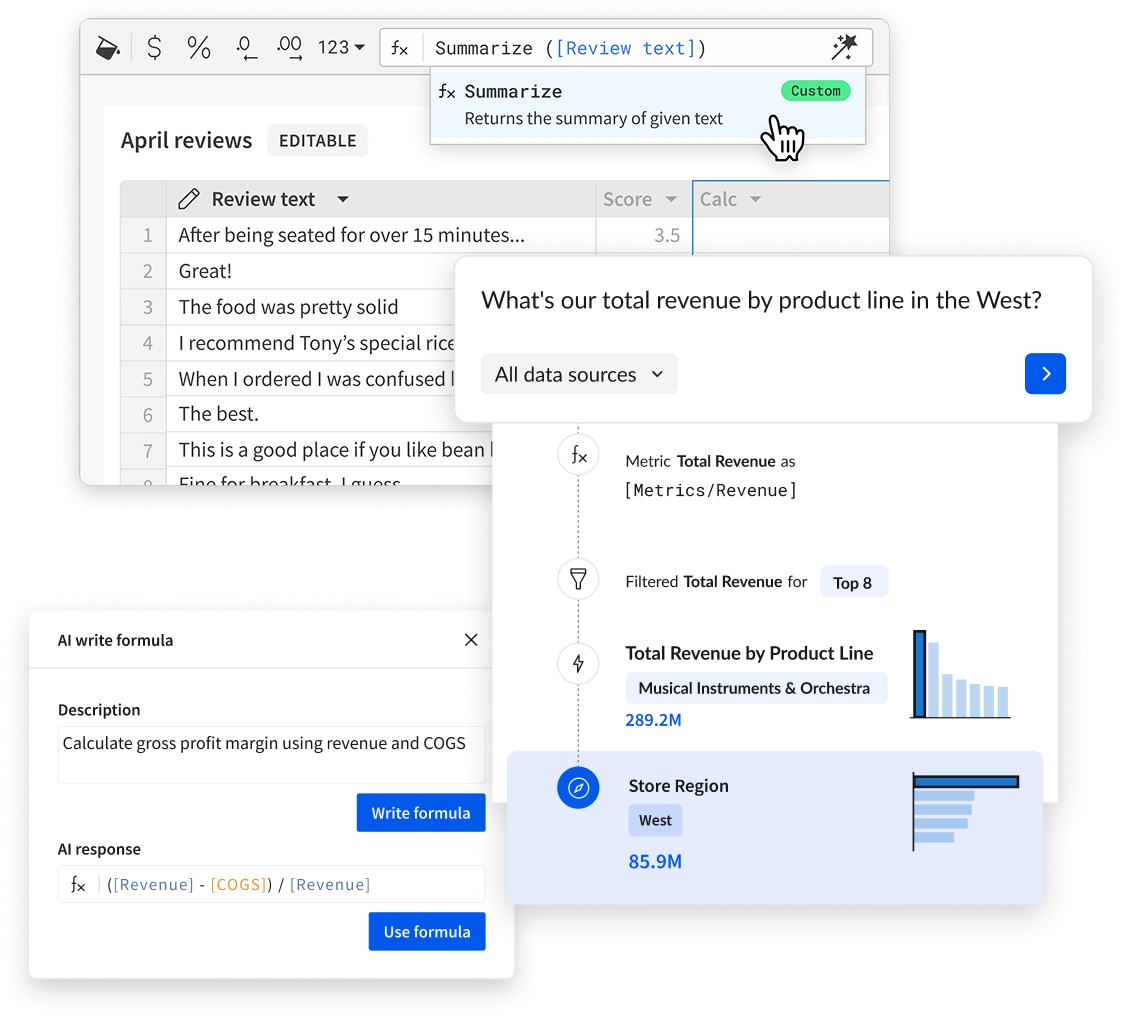
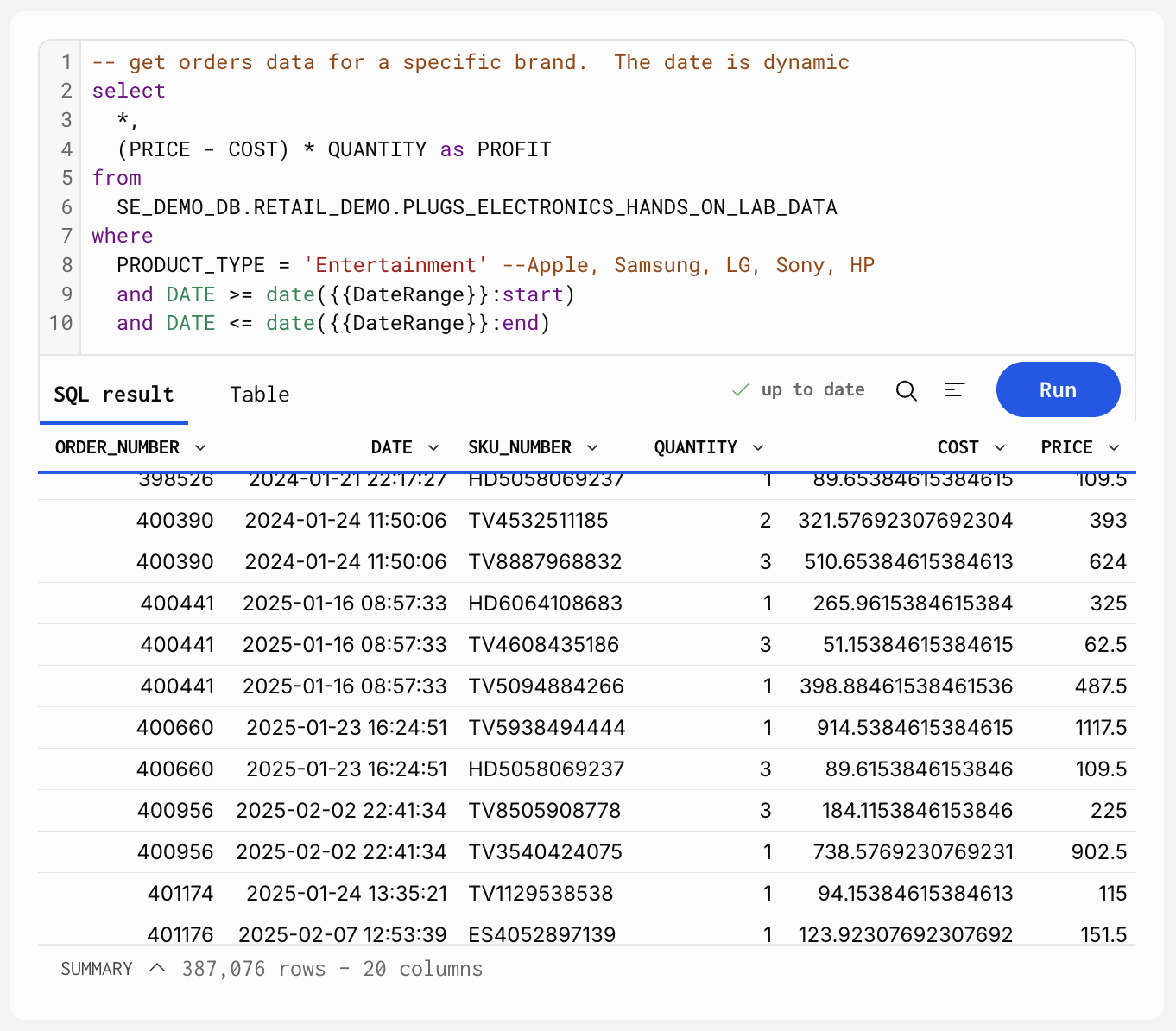
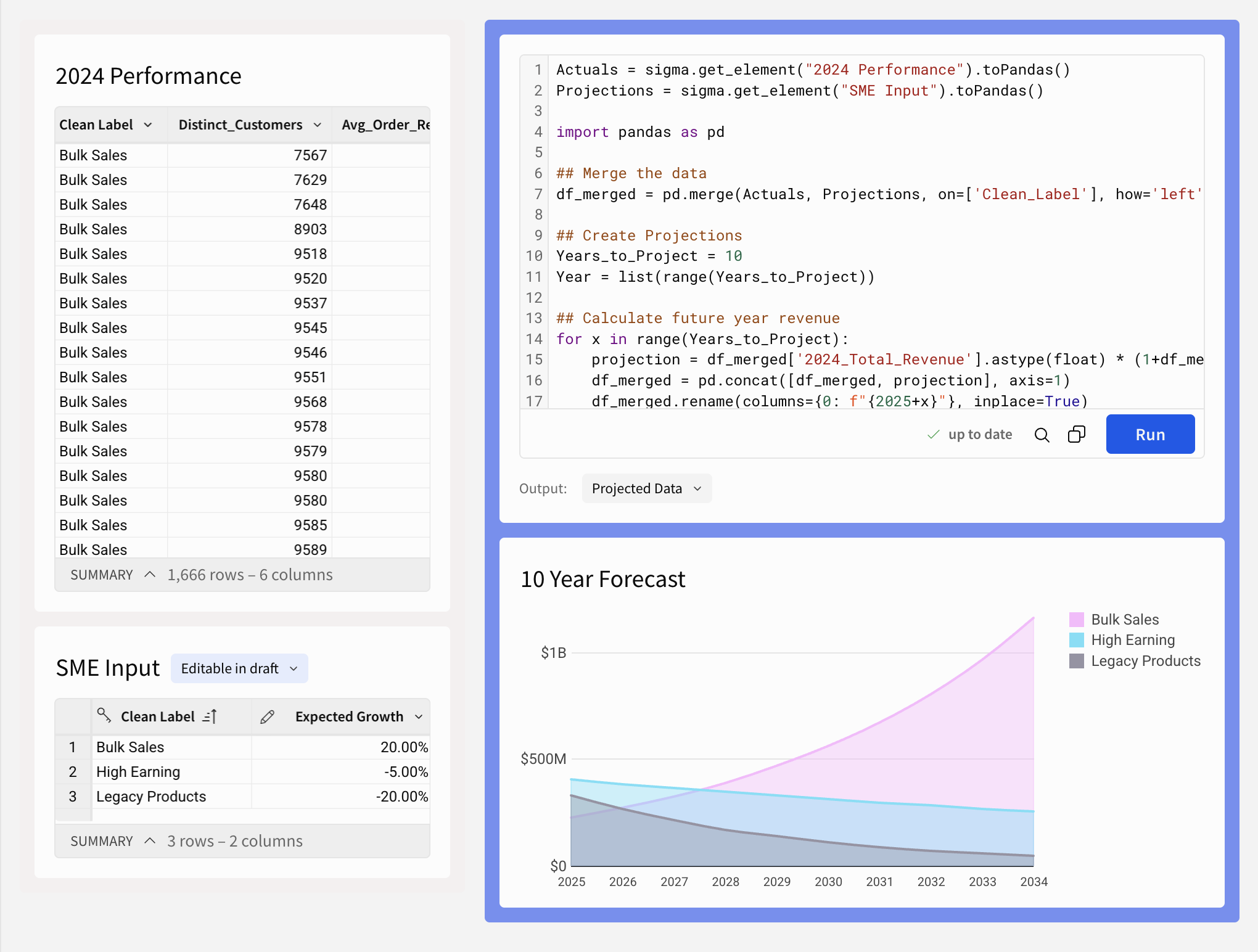
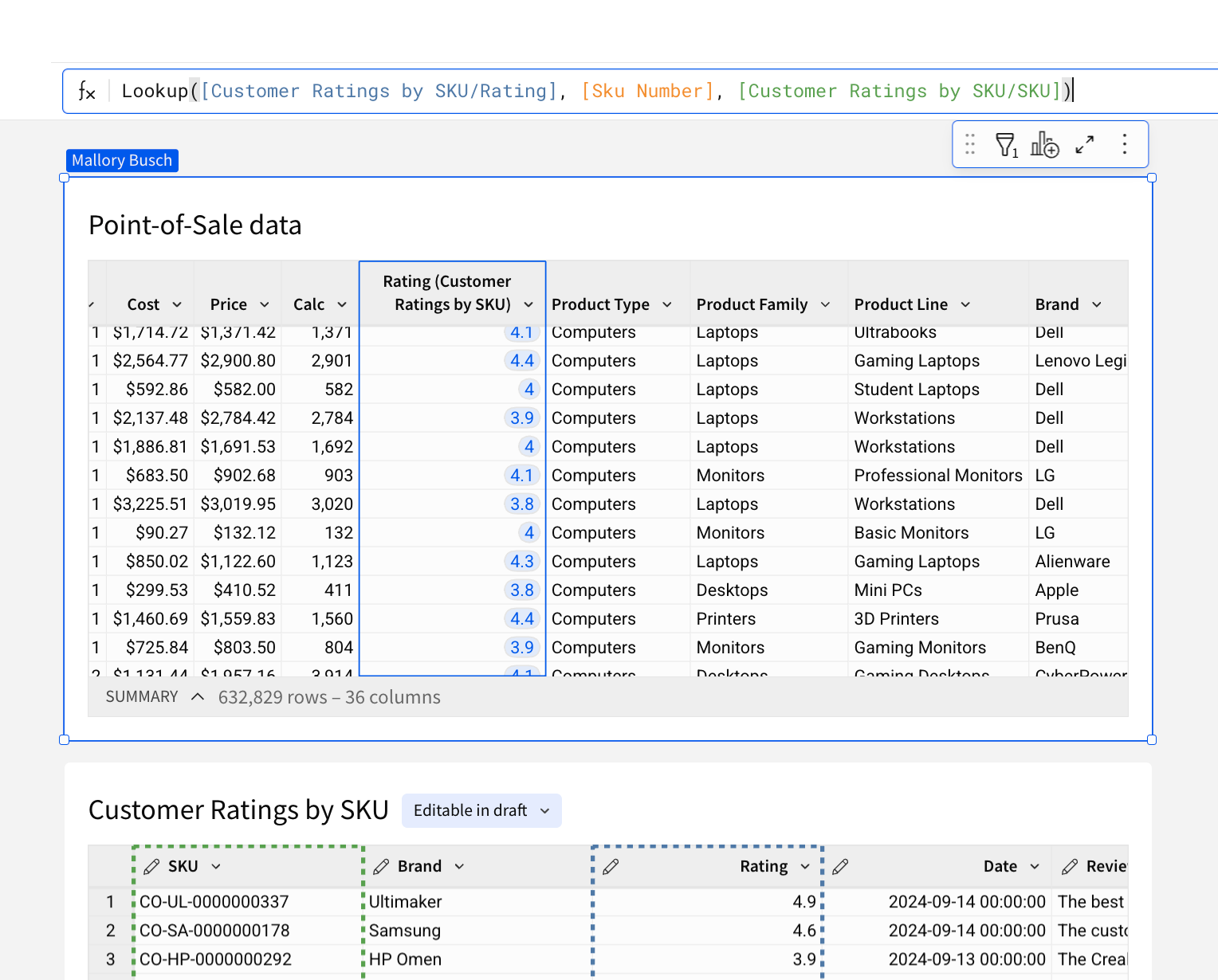


Bring the data and LLMs from your warehouse together with the governance, infrastructure, actions framework, and UI of Sigma.
Run AI analysis on your data with the LLMs provided by your cloud warehouse. Add in Sigma’s actions framework to automate workflows with AI outputs—or even create a custom AI data app.
Whether you’re writing formulas, building data assets, consuming reports, or searching for a specific answer, Sigma provides the thoughtful AI features that help you get your work done faster and easier.
Simply describe the data app or workbook you want to create, and Sigma’s AI Builder (Private Beta) will vibe code it for you. AI gets you most of the way there, and you can easily edit the details yourself—no coding skills required.

Tired of static software built for an on-prem world? Burned by acquisitions that stifled innovation? Don’t worry. Sigma is here to push the industry forward.
And there’s always more to come. Sigma has 40+ registered patents—and counting.
2025 Inductee:


"Sigma’s enterprise-ready platform has delivered value for JPMorganChase, empowering our teams across our businesses to work smarter. We recognize their exceptional efforts, cutting-edge solutions, and collaborative spirit with the Hall of Innovation Award."
Catch up on the latest innovations in analytics & BI with Sigma’s quarterly product launches.
See the Sigma Product Launches


Don’t run your business on disconnected spreadsheets. Build a data app in Sigma instead.
In Sigma, dashboards are the beginning—not the end.
Is a repeatable workflow built on your cloud data.
Writes new data back to the cloud data warehouse.
Is fully customizable to your unique business needs.
Can be built without writing any code.
A CSV uploader is not a data app.
A dashboard with a button is not a data app.
Build low-code apps using warehouse data.

Sigma’s architecture keeps data within the warehouse, compliant, and under your full control. Plus, Sigma inherits the existing security and governance of your CDW.
Sigma’s cloud-native, cloud-only technology makes it inherently more secure than the on-premises and hybrid systems that came before it. Sigma does not move, copy, or extract data from the warehouse.
Sigma has the most security and compliance certifications of any business intelligence platform built exclusively for the cloud.

Row-level security

OAuth

Column-level security

Granular permissions

Audit logs

Secure embedding with JWT

SSO & RBAC

Multiple IdP Support

Database parameterization


“I know I can always reach someone if I have a question.”
See the story

“Sigma's team has been phenomenal across all these years in supporting us, collecting feedback and building solutions based on feedback provided.”
“The support from Sigma has been outstanding. During our on-boarding, our solutions architect went above and beyond in helping us create reports that were outside of the norm and has provided continued support. Their CS team provides continued support and their product team listens to customer feedback."
“Sigma's customer support is unmatched, they have deep documentation, a holistic approach to new features, and take client feedback seriously for new development.”
.png)

"Sigma has been an amazing BI tool that has changed the way that I think about BI tools & platforms. The weekly updates, transparent product launches, and the exceptional communication from Sigma has shown they go above & beyond for their customers."
“Sigma is the best BI platform I've ever used...The UI is very easy to utilize and they've been extremely receptive to the feedback we've provided.”
“The ease of use for people on either end of the technical spectrum has been great! It has transformed the way we go to market and operate internally. We can get to answers much faster and more accurately for the entire company.”
“Wonderful overall experience from introductory demos to contracting, to implementation and post go-live. Everyone on the team is very responsive and incredibly helpful.”
“Sigma is great, it's super easy to implement and connect to the cloud DWH. Amazing reporting tool. The fact that it works with tables and has an excel look and feel makes it great for analysts / product / ops / finance & viewers.”
“The functionality seems to be endless. It connects seamlessly to our cloud data warehouse with write back capabilities. You can write SQL directly into the tool for advanced analytics. We also take advantage of the embedding functionality for our other applications.”
“Sigma fills a common gap in the business intelligence space -- a platform for users who ‘just need to see the data.’ It is easy to learn and use, comparable in look and feel to standard spreadsheet applications. It takes the strongest points of our cloud data platform and makes them available to people without technical data skill sets.”
“Having seen the evolution of the BI space from SQLing directly on a database to data visualization tools to modeling languages, Sigma feels like the next transformative technology in the space.”
“Sigma is an exceptional BI tool that increases the speed at which we are able to create dashboards and reports to generate insights… The write-back functionality has allowed us to show where we have data issues and have them updated immediately.”
“Could not be happier with Sigma. I use it for every facet of my job. The ease of reporting and analytics makes me so much more productive... Everything I previously did in Excel / Sheets (I work in Finance) I can do in Sigma faster and better and it keeps itself up to date.”
“We mostly work along with data from the BFSI Sector, so the data metrics are quite huge. But the way Sigma has the power to show the whole data in consolidated form is quite recommendable. Having Sigma has also improved Team's productivity with its simple UI / UX and application in business. A big Thumbs up to Sigma for all the automation and Business Application!!!
“Superior performance with large datasets, very intuitive and user friendly, free viewer licenses, live chat support.”
“We really enjoy working with Sigma, we've used Sigma for two years and it's a fantastic BI tool. Our end users like it, and it is continuing getting better features.”
“Support is incredibly quick with their replies, and are always available to schedule one-off troubleshooting sessions on specific topics. The online user learning community is a fantastic resource, filled with valuable tips and tricks that have helped us maximize our use of Sigma.”
“The platform is a powerhouse of current value with a product roadmap designed to achieve the analytics capabilities of tomorrow.”
“A game changer… This product has allowed us to put effective self-service data back into our business users’ hands and alleviated most of the AD-HOC requests for data that we receive daily. The time savings alone for my team as well as the business users who had to exchange and then wrangle data to make it usable was worth the cost of acquiring Sigma.”
“Sigma has empowered our organization to leverage the full potential of our semantic layer, democratizing data analysis across departments. By enabling self-service analytics, we've transformed employees at all levels into confident data decision-makers.”
“Sigma excels where many BI tools don't and are continuously adding value added features to make the tool more compelling.”
“Sigma has been an essential part of my daily workflow since we've joined the platform.”
“Sigma is the best analytics and data visualization tool we have used! It sits directly on top of your snowflake instance, which lets you access your data without writing additional business logic in the visualization platform. Creating charts is extremely easy. Our stakeholders love Sigma!”
"The tool is incredibly easy to use and intuitive for technical folks, and most importantly the company is very engaged with continuously improving their product and experience. The service is constantly getting better with a lot of new, helpful features on the horizon."